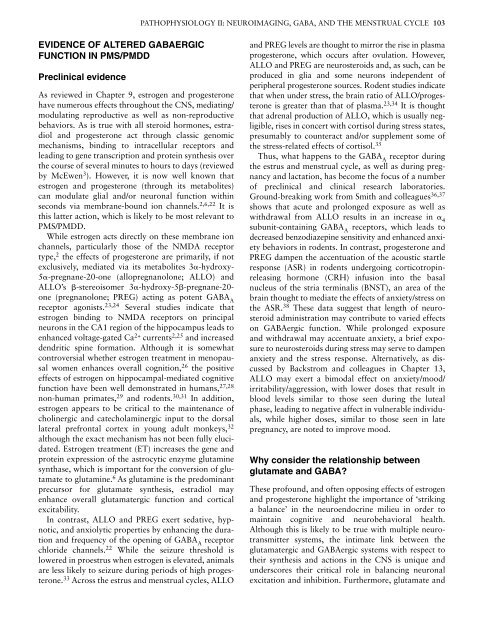Premenstrual Syndromes : PMS and PMDD - Rutuja :: The site ...
Premenstrual Syndromes : PMS and PMDD - Rutuja :: The site ...
Premenstrual Syndromes : PMS and PMDD - Rutuja :: The site ...
Create successful ePaper yourself
Turn your PDF publications into a flip-book with our unique Google optimized e-Paper software.
EVIDENCE OF ALTERED GABAERGIC<br />
FUNCTION IN <strong>PMS</strong>/<strong>PMDD</strong><br />
Preclinical evidence<br />
As reviewed in Chapter 9, estrogen <strong>and</strong> progesterone<br />
have numerous effects throughout the CNS, mediating/<br />
modulating reproductive as well as non-reproductive<br />
behaviors. As is true with all steroid hormones, estradiol<br />
<strong>and</strong> progesterone act through classic genomic<br />
mechanisms, binding to intracellular receptors <strong>and</strong><br />
leading to gene transcription <strong>and</strong> protein synthesis over<br />
the course of several minutes to hours to days (reviewed<br />
by McEwen 3 ). However, it is now well known that<br />
estrogen <strong>and</strong> progesterone (through its metabolites)<br />
can modulate glial <strong>and</strong>/or neuronal function within<br />
seconds via membrane-bound ion channels. 2,6,22 It is<br />
this latter action, which is likely to be most relevant to<br />
<strong>PMS</strong>/<strong>PMDD</strong>.<br />
While estrogen acts directly on these membrane ion<br />
channels, particularly those of the NMDA receptor<br />
type, 2 the effects of progesterone are primarily, if not<br />
exclusively, mediated via its metabolites 3�-hydroxy-<br />
5�-pregnane-20-one (allopregnanolone; ALLO) <strong>and</strong><br />
ALLO’s �-stereoisomer 3�-hydroxy-5�-pregnane-20one<br />
(pregnanolone; PREG) acting as potent GABA A<br />
receptor agonists. 23,24 Several studies indicate that<br />
estrogen binding to NMDA receptors on principal<br />
neurons in the CA1 region of the hippocampus leads to<br />
enhanced voltage-gated Ca 2+ currents 2,25 <strong>and</strong> increased<br />
dendritic spine formation. Although it is somewhat<br />
controversial whether estrogen treatment in menopausal<br />
women enhances overall cognition, 26 the positive<br />
effects of estrogen on hippocampal-mediated cognitive<br />
function have been well demonstrated in humans, 27,28<br />
non-human primates, 29 <strong>and</strong> rodents. 30,31 In addition,<br />
estrogen appears to be critical to the maintenance of<br />
cholinergic <strong>and</strong> catecholaminergic input to the dorsal<br />
lateral prefrontal cortex in young adult monkeys, 32<br />
although the exact mechanism has not been fully elucidated.<br />
Estrogen treatment (ET) increases the gene <strong>and</strong><br />
protein expression of the astrocytic enzyme glutamine<br />
synthase, which is important for the conversion of glutamate<br />
to glutamine. 6 As glutamine is the predominant<br />
precursor for glutamate synthesis, estradiol may<br />
enhance overall glutamatergic function <strong>and</strong> cortical<br />
excitability.<br />
In contrast, ALLO <strong>and</strong> PREG exert sedative, hypnotic,<br />
<strong>and</strong> anxiolytic properties by enhancing the duration<br />
<strong>and</strong> frequency of the opening of GABA A receptor<br />
chloride channels. 22 While the seizure threshold is<br />
lowered in proestrus when estrogen is elevated, animals<br />
are less likely to seizure during periods of high progesterone.<br />
33 Across the estrus <strong>and</strong> menstrual cycles, ALLO<br />
PATHOPHYSIOLOGY II: NEUROIMAGING, GABA, AND THE MENSTRUAL CYCLE 103<br />
<strong>and</strong> PREG levels are thought to mirror the rise in plasma<br />
progesterone, which occurs after ovulation. However,<br />
ALLO <strong>and</strong> PREG are neurosteroids <strong>and</strong>, as such, can be<br />
produced in glia <strong>and</strong> some neurons independent of<br />
peripheral progesterone sources. Rodent studies indicate<br />
that when under stress, the brain ratio of ALLO/progesterone<br />
is greater than that of plasma. 23,34 It is thought<br />
that adrenal production of ALLO, which is usually negligible,<br />
rises in concert with cortisol during stress states,<br />
presumably to counteract <strong>and</strong>/or supplement some of<br />
the stress-related effects of cortisol. 35<br />
Thus, what happens to the GABA A receptor during<br />
the estrus <strong>and</strong> menstrual cycle, as well as during pregnancy<br />
<strong>and</strong> lactation, has become the focus of a number<br />
of preclinical <strong>and</strong> clinical research laboratories.<br />
Ground-breaking work from Smith <strong>and</strong> colleagues 36,37<br />
shows that acute <strong>and</strong> prolonged exposure as well as<br />
withdrawal from ALLO results in an increase in � 4<br />
subunit-containing GABA A receptors, which leads to<br />
decreased benzodiazepine sensitivity <strong>and</strong> enhanced anxiety<br />
behaviors in rodents. In contrast, progesterone <strong>and</strong><br />
PREG dampen the accentuation of the acoustic startle<br />
response (ASR) in rodents undergoing corticotropinreleasing<br />
hormone (CRH) infusion into the basal<br />
nucleus of the stria terminalis (BNST), an area of the<br />
brain thought to mediate the effects of anxiety/stress on<br />
the ASR. 38 <strong>The</strong>se data suggest that length of neurosteroid<br />
administration may contribute to varied effects<br />
on GABAergic function. While prolonged exposure<br />
<strong>and</strong> withdrawal may accentuate anxiety, a brief exposure<br />
to neurosteroids during stress may serve to dampen<br />
anxiety <strong>and</strong> the stress response. Alternatively, as discussed<br />
by Backstrom <strong>and</strong> colleagues in Chapter 13,<br />
ALLO may exert a bimodal effect on anxiety/mood/<br />
irritability/aggression, with lower doses that result in<br />
blood levels similar to those seen during the luteal<br />
phase, leading to negative affect in vulnerable individuals,<br />
while higher doses, similar to those seen in late<br />
pregnancy, are noted to improve mood.<br />
Why consider the relationship between<br />
glutamate <strong>and</strong> GABA?<br />
<strong>The</strong>se profound, <strong>and</strong> often opposing effects of estrogen<br />
<strong>and</strong> progesterone highlight the importance of ‘striking<br />
a balance’ in the neuroendocrine milieu in order to<br />
maintain cognitive <strong>and</strong> neurobehavioral health.<br />
Although this is likely to be true with multiple neurotransmitter<br />
systems, the intimate link between the<br />
glutamatergic <strong>and</strong> GABAergic systems with respect to<br />
their synthesis <strong>and</strong> actions in the CNS is unique <strong>and</strong><br />
underscores their critical role in balancing neuronal<br />
excitation <strong>and</strong> inhibition. Furthermore, glutamate <strong>and</strong>


